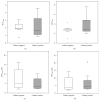Intensity of 18F-FDG PET Uptake in Culture-Negative and Culture-Positive Cases of Chronic Osteomyelitis
- PMID: 29114183
- PMCID: PMC5660764
- DOI: 10.1155/2017/9754293
Intensity of 18F-FDG PET Uptake in Culture-Negative and Culture-Positive Cases of Chronic Osteomyelitis
Abstract
Microbiologic cultures are not infrequently negative in patients with a histopathologic diagnosis of chronic osteomyelitis. Culture-negative cases may represent low-grade infections with a lower metabolic activity than culture-positive cases. 18F-FDG PET could potentially detect such a difference. We determined whether the level of 18F-FDG PET uptake differs in patients with culture-negative and culture-positive osteomyelitis. We reviewed the clinical charts of 40 consecutive patients, who had diagnostic 18F-FDG PET for a suspected bone infection. Twenty-six patients were eligible with a confirmed diagnosis based on microbiologic cultures and/or histopathologic examination. Sixteen of 26 patients had chronic osteomyelitis. Eight of them had positive cultures, seven had negative cultures, and one patient had no cultures of the biopsy specimen. The patients with histologically and/or microbiologically proven osteomyelitis were correctly interpreted as true positive in the routine clinical reading of 18F-FDG PET images. There was no relationship between the level of 18F-FDG PET uptake and the presence of positive or negative bacterial cultures. The result favors the concept that that culture-negative cases of osteomyelitis are false-negative infections due to nonculturable microbes. 18F-FDG PET may help to confirm the presence of metabolically active infection in these patients and guide their appropriate treatment.
Figures


References
-
- Termaat M. F., Raijmakers P. G. H. M., Scholten H. J., Barker F. C., Patka P., Haarman H. J. T. M. The accuracy of diagnostic imaging for the assessment of chronic osteomyelitis: a systematic review and meta-analysis. The Journal of Bone and Joint Surgery—American Volume. 2005;87(11):2464–2471. doi: 10.2106/jbjs.d.02691. - DOI - PubMed
Publication types
MeSH terms
Substances
LinkOut - more resources
Full Text Sources
Other Literature Sources
